
views
- Number of Players: 2–6 players or teams
- Materials Needed: Scattergories game, pens or pencils
- Objective: Earn the most points after 3 rounds by listing unique words for each category starting with the chosen letter.
Setting up the Game

Gather 2 or more people to play the game. Scattergories works great for any group size as long as everyone is around 12 or older. While the game only comes with enough components for 6 people, if you have a large number of players, just split into teams to work together. Teams of 3 or fewer are usually best so you’re not talking over each other trying to think of answers later on. Want to play with friends remotely? Create a room on Really.Boring.Website and invite your friends to an online game.

Give each person an answer sheet, folder, and pencil. Slide an answer sheet under the clip inside each of the cardboard folders, and hand one to each player or team. Older editions may come with pencils but newer editions may not. Just give everybody who’s playing something to write with. The current edition of the game comes with an hourglass or battery-powered timer, a 20-sided letter die, 6 cardboard folders, 6 copies of each of the 13 category cards, and a pad of answer sheets. Each answer sheet has 3 columns that each have 12 blank spaces that you’ll fill in during the game. If you don’t have any answer sheets, you can use any piece of paper! Draw 3 columns that each have 12 blank lines to fill in your answers. If you’re playing on Zoom, keep track of your answers in a text document. If you’re using a site to play Scattergories, check if there are any text boxes on the page to fill in your answers.
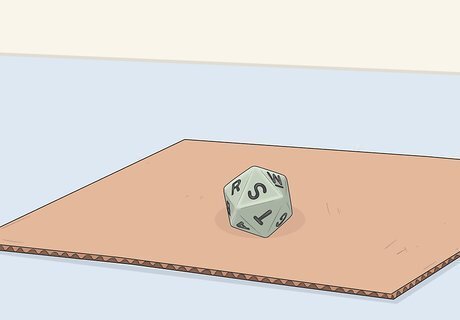
Set the letter die and timer on a flat surface nearby. If your Scattergories game came with an extra cardboard rolling mat, set it out in the middle of the table and put the 20-sided die on top. Then, put the timer within reach so someone can easily start it at the beginning of each round. The cardboard rolling mat is optional, but it helps protect your tabletop from the heavy die that could leave dings or dents. If you don’t have a rolling mat, roll the die on a cutting board or in a dice tray. If you have an electric timer and it’s your first time playing, make sure it has batteries and put them in if needed. If you don’t have a timer at all, set one on your phone or just Google “timer” to have one on your computer.
Gameplay
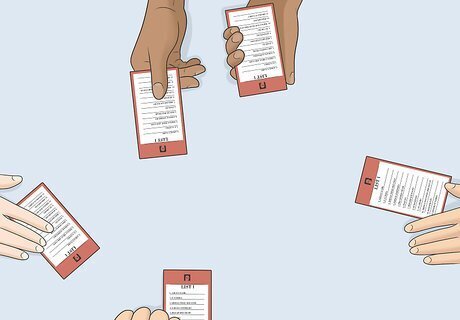
Give each player or team a copy of the same category card. Each category card has a list of 12 random categories, such as “Things in the kitchen,” “Celebrities,” or “Outdoor activities.” Choose one set of the double-sided category cards and hand them out to each player. Make sure everyone has the same category number showing since everybody will use the same list during the first round of the game. The game also comes with blank category cards to let you make your own custom categories. If you have ideas for categories not on any of the other cards, write them down on one of the blank cards. If you’re playing over Zoom, send the categories over chat so everyone can see them. If you’re playing Scattergories online, the categories will automatically appear for everyone in the browser.
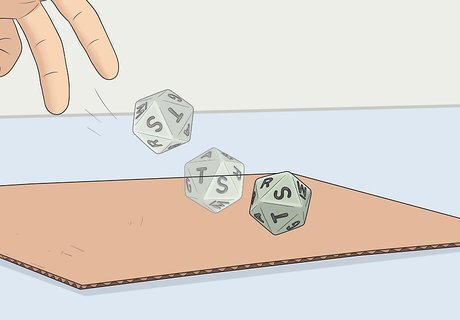
Roll the letter die to select the starting letter for the round. The 20-sided letter die shows every letter of the alphabet except for Q, U, V, X, Y, and Z. Choose any player to roll the die and announce the letter that comes up to the other players. This letter determines what each answer must start with once you start the round. The 6 omitted letters aren’t on the letter die since it’s tough to think of a variety of words that start with them. If you and the other players want a challenge, assign each of these letters to a number on a 6-sided die and roll that instead. For playing virtually, have a person roll and send the letter in a group chat.

Start the 3-minute timer. Make sure all of the players are ready to start the round. Then, if your game has an hourglass timer, flip it over so the sand starts running into the bottom. If you have an electric timer, press the button on top to start the countdown. Want a more challenging game? Instead of using the hourglass, set a timer for 2 or 2 ½ minutes on your phone or watch so you have less time.
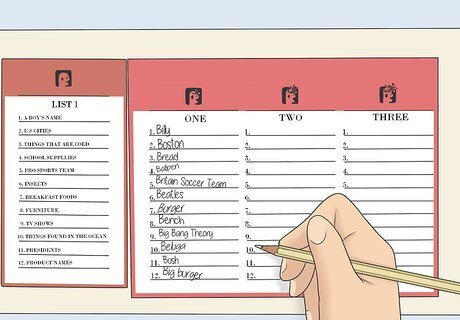
Write down a word starting with the round’s letter for each category. Look through each of the 12 categories and quickly brainstorm an answer for each one that starts with the letter on the die. Try to think of unique answers so you’re less likely to write something another player put down. When you have a unique answer, fill the answers in the first column of your sheet. Once the timer runs out, stop writing even if you missed a few categories. Example: If the category is “Boy Names” and the letter on the die is “P,” you might write down “Phil” or “Patrick” as your answer. The words “a,” “an,” and “the” don't count if they're the first word of your answer. If the category is “Movie,” then “The Dark Knight” would be an appropriate answer for the letter “D,” but not for the letter “T.” If the answer you think of is a person, their first name or last name can start with the selected letter. If you roll the letter “J” and the category is “Basketball Player,” both “Julius Irving” and “Michael Jordan” are perfect answers. Avoid using adjectives unless they’re part of the actual word. For example, if the category is “Vegetables” and the letter is G, “green beans” is an acceptable answer but “green lettuce” isn’t. You’re not allowed to use the same answer for multiple categories. If you are playing as part of a team, be sure to write down any answers you want to suggest instead of saying them out loud. You don't want your opponents to steal your answers!
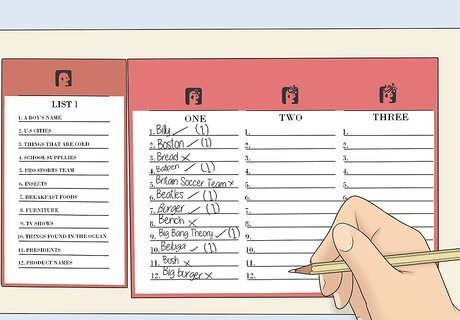
Gain 1 point for each answer if no other players wrote it down. Choose any player or team to start and have them read their answer for the first category. Go around to each player or team to hear their answer. If no one else has written down the same answer as you or your team, then you earn 1 point. If someone said the same thing as you, then anyone with that answer earns no points for that category. Continue reading your answers for each category to tally scores for the first round. Example: The category is “Boy Names” and the letter is “P.” You write “Phil”, player 2 writes "Peter," and players 3 and 4 both write “Paul.” You and Player 2 both get 1 point since your answers were unique. Since Players 3 and 4 both had the same answer, neither of them get points for that category. Variation: Give a bonus point for each word in your answer that uses alliteration and the letter for the round. For example, if the category is “Cartoon Character” and the letter rolled was “P,” earn 2 points for the answer “Peter Parker” or “Peppa Pig.”
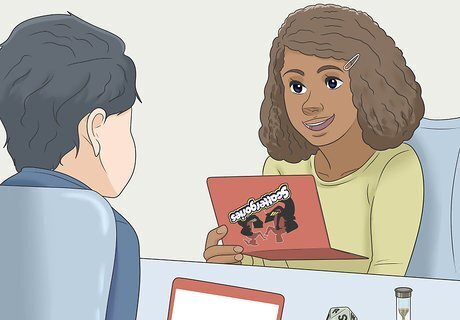
Challenge other players' answers if you think they don't fit the category. Since everybody is trying to make sure that their answers are unique, they might come up with creative words or phrases that don't quite fit the category. If you disagree with an answer someone wrote, tell them you’re challenging it. Every player takes a vote and if the majority of players believe the answer doesn't fit, then the player who wrote it doesn't get points for it. If the votes are tied, then the challenged player's vote doesn't count. Example: If the category is “Animal” and the letter is “J,” the answer “jackalope” may get challenged since it’s a fictional animal.
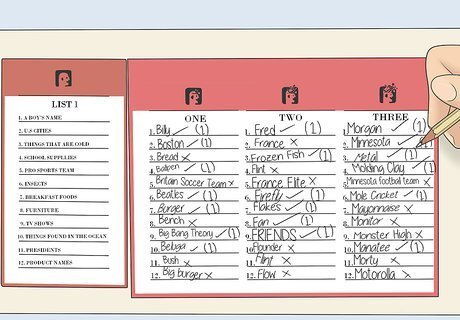
Choose new categories and letters to play rounds 2 and 3. At the beginning of each round, choose a new set of category cards and hand them to each player or team. Roll the die to select a new letter for the second round, but reroll if it shows a letter you used in any previous round. Play rounds 2 and 3 the same as the first one using the second and third columns on your answer sheet.

Win the game if you earn the most points after 3 rounds. At the end of round 3, add the points from each round together to find out the grand total for you or your team. If you have the highest score, then you win the game! If there’s a tie, play one more round with a new letter and set of categories.


















Comments
0 comment